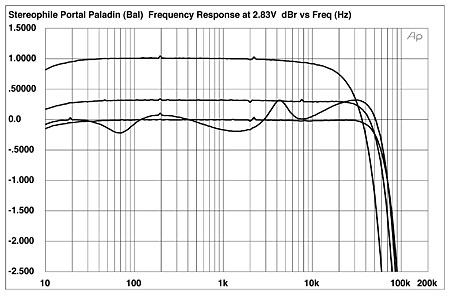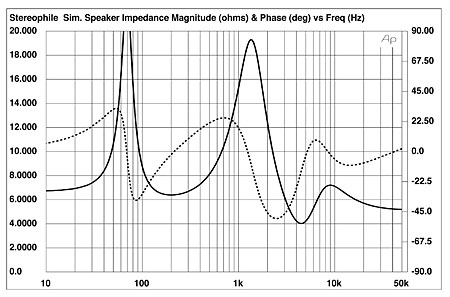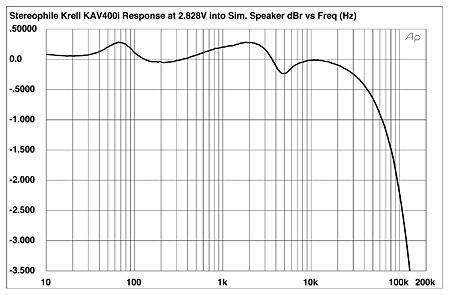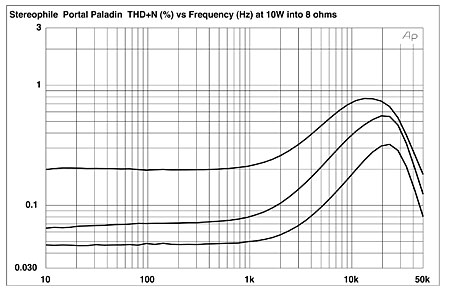| Columns Retired Columns & Blogs |
Portal Audio Paladin monoblock power amplifier Measurements
Sidebar 3: Measurements
I preconditioned one of the Portal Paladin monoblocks by running it for 60 minutes at one-third the measured clipping power into 8 ohms. With the amplifier cold, the measured THD+noise was 0.06%; with it hot, this changed only very slightly, to 0.064%. At the end of the hour the amplifier's heatsinks were very hot, though the top panel and chassis were around 55°C—not too hot to keep my hand on. The amplifier's voltage gain differed, depending on whether the unbalanced or balanced input jack was used. With balanced drive, the voltage gain was very slightly higher than specified, at 28.9dB. With unbalanced drive, however, the gain was a very high 35.7dB. Both inputs were noninverting.
The Paladin's input impedance depended on the setting of its impedance switch. With this set to "10k," the balanced input impedance was 50k ohms across the audioband; at "100k," the balanced impedance was around 180k ohms at all frequencies. The unbalanced situation was very different: with the switch set to "10k," the input impedance measured 10.5k ohms at all frequencies; however, at "100k" the input impedance actually dropped to 6.9k ohms. This is low enough to give rise to a somewhat lean-sounding bass with some tube preamps that have a rise in their single-ended output impedance at low frequencies.
The Conrad-Johnson CT-5 that Wes Phillips used for his auditioning, for example, has an output impedance of 800 ohms in the midrange and treble, but 1836 ohms at 20Hz. Used with the Paladin set to "100k," this will give an output that is down 1.1dB at 20Hz. This will be just audible, not necessarily as a lack of low frequencies but more, perhaps, as better bass definition.
I measure an amplifier's output impedance by examining how much its open-circuit output voltage drops when it is loaded by 8 and 4 ohm resistors. The Paladin thwarted my attempts because its output voltage rose when its output was loaded down, meaning it has a negative output impedance of around 0.3 ohm. Both samples behaved this way; I suspect that some positive feedback is used to compensate for the fact that a balanced output stage, in which the speaker load is connected between the "hot" terminals of two separate amplifiers, has an intrinsically higher impedance than a conventional amplifier, in which the "cold" speaker terminal is connected to ground. As a result of this negative impedance, the amplifier's frequency response into our standard simulated loudspeaker (fig.1, bottom trace at 70Hz) was the inverse of its impedance curve (fig.2). This is very different from a conventional amplifier with a similar output impedance (fig.3), and the differences in frequency response between the Paladin and other amplifiers will be large enough to be audible.

Fig.1 Portal Paladin, balanced frequency response at 2.83V into (from bottom to top at 2kHz): simulated loudspeaker load, 8, 4, 2 ohms (0.5dB/vertical div.).

Fig.2 Stereophile's simulated loudspeaker, electrical impedance (solid) and phase (dashed). (2 ohms/vertical div.)

Fig.3 Krell KAV-400xi, balanced frequency response at 2.83V into simulated loudspeaker load (0.5dB/vertical div., right channel dashed).
The Paladin's bandwidth is also dependent on the load impedance. The bottom trace at 20kHz is the frequency response into 8 ohms: flat in the audioband, it is down 3dB at 95kHz. But when the load is halved, to 4 ohms, not only does the output rise by 0.35dB, the 3dB-down point drops a little, to 80kHz. Into 2 ohms, not only does the level again rise by another 0.65dB, the response is –0.2dB at 20kHz and –3dB at 57kHz. This decrease in small-signal bandwidth with decreasing load impedance will not have any subjective consequences, but it does raise my eyebrows a little. The squarewave responses at 1kHz (fig.4) and 10kHz (fig.5) into 8 ohms show a little overshoot, but this was not apparent into 2 ohms (not shown).

Fig.4 Portal Paladin, small-signal 1kHz squarewave into 8 ohms.

Fig.5 Portal Paladin, small-signal 10kHz squarewave into 8 ohms.
The Paladin was quite quiet, its wideband, unweighted signal/noise ratio (ref. 1W into 8 ohms) measuring 81.3dB. The A-weighted figure was 86.3dB. Fig.6 shows how the THD+noise percentage in the Portal's output varied as the power was increased into 8, 4, and 2 ohms. (The latter trace breaks off at 440W into 2 ohms because the amplifier shut down at that point, its front-panel LED glowing red rather than orange.) Into the higher impedances, the Paladin offers low levels of THD before clipping, though each trace features a minimum value between 10W and 20W output. The amplifier definitely works harder into 2 ohms, but the important point to note from this graph is that the Paladin considerably exceeds its specified output power, even taking into account the fact that my AC wall voltage was 125V during these tests. At 1% THD+N (our definition of clipping), the Portal put out 305W into 8 ohms (24.8dBW), 1.8dB higher than the specified 200W. Into 4 ohms, the amplifier clipped at 450W (23.5dBW), compared with the specified 360W (22.55dBW).

Fig.6 Portal Paladin, distortion (%)vs 1kHz continuous output power into (from bottom to top at 100W): 8, 4, 2 ohms.
I plotted the percentage of THD+N present in the Paladin's output against frequency at 9V output, close to the level where the minimum point in the fig.6 traces occurs. The result is shown in fig.7. The Paladin offers very low distortion at bass and midrange frequencies into 8 and 4 ohms, but higher levels into 2 ohms and in the top audio octave. Perhaps more important, the distortion content (fig.8) has some higher-harmonic content present. This is coincident with the waveform's zero-crossing points, which suggests that the Paladin's output stage is a little under-biased. This harmonic content can also be seen in the spectrum of the amplifier's output while it drove a low-frequency tone at high power into 8 ohms (fig.9). The highest-level harmonic is the relatively benign third, at –64dB (0.06%), but the more problematic fifth, seventh, and ninth harmonics also make appearances, between –80dB and –90dB. These latter harmonics also increased in level when the load impedance was halved (not shown). Note, by the way, the appearance of the second harmonic in fig.9. Though this is low in level, at –80dB (0.01%), it does suggest some very slight imbalance between the two active amplifier sections.

Fig.7 Portal Paladin, THD+N (%)vs frequency at 9V into (from bottom to top): 8, 4, 2 ohms.

Fig.8 Portal Paladin, 1kHz waveform at 10W into 4 ohms (top), 0.086% THD+N; distortion and noise waveform with fundamental notched out (bottom, not to scale).

Fig.9 Portal Paladin, spectrum of 50Hz sinewave, DC–1kHz, at 100W into 8 ohms (linear frequency scale).
Finally, the Paladin's decreasing linearity in the top audio octave means that it doesn't perform well on the demanding two-tone high-frequency intermodulation test. Even though the amplifier's output level was below clipping into 4 ohms for this test, the equal mix of 19kHz and 20kHz tones produced plenty of high-order modulation products (fig.10). The 1kHz difference tone was relatively low in level at –74dB (0.02%), however. Admittedly, it is virtually impossible for the amplifier to be asked to reproduce this kind of signal when playing music, but it does suggest some of the compromises that were necessary to be able to manufacture such a powerful amplifier at such an affordable price.—John Atkinson

Fig.10 Portal Paladin, HF intermodulation spectrum, DC–24kHz, 19+20kHz at 320W peak into 4 ohms (linear frequency scale).
- Log in or register to post comments




































